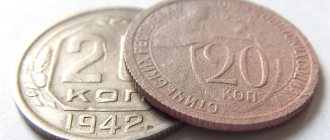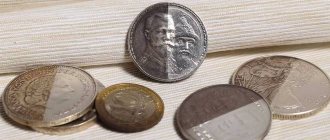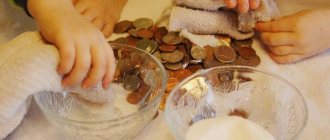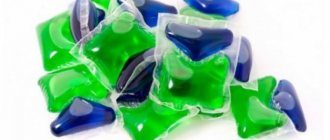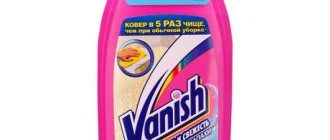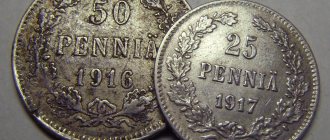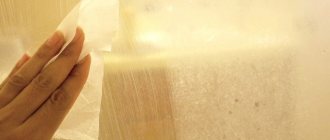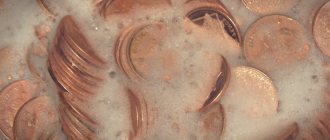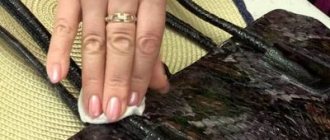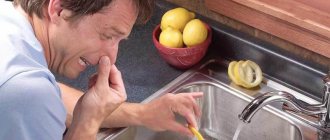- Lemon acid
To make coins, various metals and alloys are used, which are susceptible to corrosion and oxidation, which not only spoils the appearance of the product, but also reduces the cost of especially valuable royal, Soviet and anniversary coins. This problem raises the question of how to clean coins without damaging them.
Ancient coins are valuable for history. To maintain their original appearance, provide suitable storage conditions and periodically carry out preventive cleaning.
Mechanical, chemical and ultrasonic cleaning methods will help restore metal money to a presentable appearance and extend its shelf life . The choice of method depends on the type of metal, nature and degree of contamination. The article contains useful recommendations and the most effective methods that will help preserve the purity of ancient and modern coins.
Features of cleaning products made from different materials
When choosing a method and means of cleaning coins, it would be correct to take into account the material from which they are made. The right approach will quickly and effectively restore the product's shine without damaging it.
Gold and silver
Numismatists usually value items made of silver and gold. They require careful care and special storage conditions. Money made from precious metals should be stored separately from other banknotes, otherwise they will oxidize and will have to be washed much more often.
The correct choice of cleaning method and means will preserve the shine of gold coins and their value.
To clean gold and silver money, use gentle products, avoid aggressive substances and excessive mechanical impact.
Dry cleaning
You can wash stains on banknotes made of precious metals with a 10% ammonia solution. First, soak the products for several days in distilled water, and then for an hour in an ammonia solution. After the allotted time, rinse them and wipe dry.
When working with ammonia, take precautions: wear rubber gloves and open a window for ventilation.
Mechanical cleaning
Mechanical cleaning with brushes of different hardness will help remove minor dirt. To begin, soak the fines in distilled water for several days. Then polish it with a toothbrush, thoroughly cleaning the surface. To remove heavy stains, additionally use a mild soap solution.
Copper
You can clean copper coins using various means. The choice of method depends on the type of contamination. To remove red deposits, soak the fines in a 5% ammonia solution for 2 minutes. get rid of green stains , and acetic acid will help get rid of yellow stains.
To protect coppers from the negative effects of the environment, evenly cover them with patina - a special protective layer
After cleaning the coppers, perform the final stage of care:
- Rinse items with distilled water.
- Dry well with a napkin or soft towel.
- To create a protective layer, dissolve 50 g of copper sulfate in 1 liter of distilled water and add 5 g of potassium permanganate. Heat the mixture to +90 ℃.
- Dip the products into the solution and soak for several minutes. Turn them over periodically during processing so that the patina evenly covers the surface.
Nickel and bronze
Products made of nickel and bronze can be cleaned yourself at home, using improvised or special products.
Salt and vinegar
Step-by-step cleaning instructions:
- Prepare a solution based on table vinegar and salt.
- Soak nickel money in liquid.
- After soaking, treat the surface with an eraser and then polish with a soft cloth.
After cleaning, be sure to rinse the small items with running water and wipe dry with a soft cloth or paper napkin.
"Trilon-B"
For cleaning, prepare a glass container and Trilon-B product. Pour the powder into a container and add boiled water. Dip money into the solution, leave until the stains are completely cleaned, then dry and polish.
Bimetal
Bimetallic coins are an alloy of several metals. When choosing a cleaning method and means, it is important to consider the characteristics of each of them.
Safe and effective means of cleaning ten-ruble bimetal coins:
- Toothpaste . Apply a small amount of product to the brush and treat the products under running water. Remember, after cleaning the change may darken a little.
- "Coca Cola" . Soak bimetallic rubles in a carbonated drink overnight, and in the morning, rinse and dry thoroughly. To achieve maximum effect, repeat the procedure for 7 days.
- Formic acid and alcohol . Prepare a solution based on these components and immerse the products in it for 5 minutes. This treatment will restore the shine and beauty of the coins.
To clean bimetallic money, choose gentle products to avoid damaging valuable items (pictured are bimetallic coins with a denomination of 10 rubles)
Basic alloys and metals
Typically, products are minted from several metals. Each type has its own most suitable cleaning method.
- The most expensive metal is platinum. They were first released in the Russian Empire;
- Gold money began to be produced almost from the time of its invention;
- Silver specimens have been made since the 6th century BC;
- Copper has been used for coinage since antiquity;
- Tin is used as a constituent of alloys;
- Nickel coins began to be produced in 1850;
- Zinc money has been made since World War II;
- Aluminum money appeared at the end of the First World War;
- Iron money began to be issued back in the 16th century BC;
- Bronze.
Cleaning can be done both mechanically and chemically.
Cleaning using bristle brushes of varying degrees of hardness is called mechanical. It is strictly forbidden to use metal objects for this purpose.
This method is used to remove dirt and dust, being careful not to damage the surfaces.
In case of extensive contamination, dry cleaning with various oxides is used, which differ depending on the material of manufacture.
Cleaning coins with special means
Special household chemicals will help restore metal money to its original shine and purity. The products are available in the form of liquids or sprays and are effective, but require compliance with certain rules of use.
Cleaning algorithm:
- Read the instructions on the packaging and follow them carefully.
- Take the recommended safety measures - wear gloves, avoid contact of the product with skin or mucous membranes, and do not inhale fumes.
- Treat the fines with chemicals according to the instructions.
- After the set time has expired, rinse the product with water and dry.
Professional coin cleaners are highly effective and remove traces of corrosion, oxidation, and dirt in a few minutes.
The following products are especially popular: “Asidol-M”, Silbo, Leuchtturm, Shine Coins. With their help you can clean products made of gold, silver, copper, brass, bimetal . When choosing, consider the degree of contamination, the type of metal, and carefully read the instructions before use.
What accessories should I use to clean coins at home?
To prevent accidental touching from spoiling the condition and leaving fingerprints, use special devices:
- Numismatic tweezers. Needed to move products. There are 2 types - direct or reverse.
- High quality gloves. Necessary for protection from accidental touches (especially after drying).
- Plastic capsules. Needed for reliable protection of valuable specimens on both sides.
- Special liquids for cleaning coins. Please note that both Russian and foreign funds are presented on the market. But you need to take into account what specific metal this or that composition is intended for.
The online store catalog presents numismatic accessories for processing and storing coins.
Using Home Remedies
You can effectively clean an old coin or a penny from the times of the USSR using affordable home remedies without the use of expensive drugs.
Lemon acid
Cleaning technology:
- Prepare ceramic or plastic dishes. Do not use a metal bowl to avoid oxidation of the metal.
- Pour warm water into the container, add citric acid and stir.
- Dip coins into the resulting solution for 10-15 minutes. The exact treatment time depends on the degree of contamination.
- Rinse the money under running water and wipe dry with a soft cloth.
An alternative to citric acid is lemon juice diluted with a small amount of water.
An effective and affordable home remedy for cleaning metal money is citric acid or lemon juice.
Soap solution
To prepare a detergent, grate a bar of laundry or baby soap and dissolve it in warm water. Dip coins into the soapy solution and leave for several days.
After the allotted time, take out the products, treat them well with a soft brush, and then rinse with water. If necessary, repeat the procedure several times. Wipe the cleaned items dry or dry them naturally.
Vinegar + toothpaste
The following method will help get rid of traces of corrosion:
- Dip the fines in a 5% vinegar solution.
- After 5 minutes, treat the money with a soft brush and a small amount of toothpaste.
- During the process, be careful not to damage the products.
- Rinse the coppers under running water and wipe dry.
To clean coins from rust and oxidation, use auxiliary tools - brushes of different hardness, needles, napkins, etc.
You can clean it with vinegar alone. To do this, soak the change for 2 hours, and then rub the stained areas with aluminum foil. Rinse the cleaned coin under running water and dry.
"Coca Cola"
Coca-Cola contains a large amount of phosphoric acid, which effectively removes minor stains and traces of corrosion. To clean, pour a carbonated drink into a glass, put coins in it and leave for 5-7 days. After a week, remove the items, clean them with a soft brush, rinse under running water and wipe dry.
Baking soda
To restore shine and purity to coins, use a sodium bicarbonate solution. To prepare it, mix soda, toothpaste and ammonia. Rub the resulting mixture onto the fines, and then rinse with running water.
Baking soda effectively removes dirt and corrosion from small items
"Oil" boiling
Heat Vaseline or vegetable oil in a water bath. Immerse the fines in the hot liquid for 10 minutes. After cooling, rinse and boil the products in distilled water.
This cleaning method is ideal for money made of bronze and other alloys, but is contraindicated for silver items.
Hydrochloric acid
Hydrochloric acid is most often used to clean coins made from zinc and iron alloys . The acid solution should be weak (ratio with water - 1:10). Coins are first cleaned of rust and white deposits using a sewing needle or medical scalpel. After the “acid therapy”, the coins are washed in cold running water. Dry (and at the same time wipe) on a piece of felt or even felt boots.
It must be borne in mind that after treatment with hydrochloric acid, coins are covered with a layer of quite durable dark patina. If it needs to be removed, abrasive materials must be used.
In no case should you use concentrated acids (not only hydrochloric acid, but also acetic, nitric and others) to clean coins - they can melt the design on the coins.
Electrolysis as a way to clean coins
Electrolysis will help restore the glossy shine and purity of metal money. During the procedure, contaminants are destroyed by exposure to electric current.
Cleaning algorithm:
- Prepare a 6-12 volt power supply with alligator clips attached.
- Take a small metal object, but do not use a copper or brass item.
- Prepare a glass container and fill it with saline solution (1 tablespoon of salt per 1 liter of water).
- Attach one clip to a coin and the other to a metal object.
- Immerse the items in the saline solution and plug the power supply into an outlet.
- Under the influence of current, dirt and oxide will dissolve. After some time, the coin will become clean and shiny. The duration of treatment depends on the degree of contamination
- After the procedure, rinse the product with hot water and dry.
To visually familiarize yourself with the cleaning process, watch the video:
Antique pennies are often found in the ground, they gather dust in the homes of collectors and random people, and do not always look presentable. Often the products are rusty, covered in dirt, blackness and corrosion. This reduces their value. Available home remedies or professional household chemicals will help restore your coins' glossy shine, purity and radiance.
What not to do
barbaric methods
1. Mechanical cleaning by friction with a rag, carpet, etc. (in common parlance – “cleaning with felt boots”). Sometimes GOI paste (green, like plasticine) can be used, but it only worsens the damage to the coin. GOI paste can only be used for certain types of jewelry (not antique), where shine is of paramount importance. In general, its main purpose is to clean optical lenses.2. Rough chemical cleaning with acids and other aggressive compounds. In addition to removing dirt and oxides, part of the surface disappears, and bumps and dents form. Any acids must be diluted with water (preferably distilled) in a ratio of at least 1/7.3. Scratching a coin with metal or other objects in order to remove a layer of dirt. In this case, the surface deteriorates irrevocably, scratches and gouges appear. The method can only be used to remove adhered dirt, and only with a wooden object (for example, a toothpick)
If the coin is not valuable, you can use a toothbrush, but be extremely careful.
Paste GOI
This method is used by newbie collectors. GOI paste removes blackness from metal and makes it bright and shiny. The paste does not remove serious oxides or calcium deposits.
But experienced numismatists do not approve of the use of this tool. GOI paste is soft but abrasive. During processing, you will remove light dirt, but damage the protruding elements of the coin: the edge and the design. The more you try, the more actively you remove dirt, the more you smooth out the chasing.
At the end you will get a shiny coin with “licked” small details. This is not a problem when you are cleaning your silverware. But for collectible coins this result is unacceptable.
The exception is when you need to remove a small stain on the smooth part of the coins. In this case, dip a cotton swab into the paste and carefully wipe the problem area with the tip.
Coca-Cola Classic
A non-standard method that few numismatists use is cleansing with Coca-Cola.
And you don’t need to invent it, but take the usual classic version in a red jar. No Zero, Cherry or other flavors. Sometimes the result can be shocking in the good sense of the word. The liquid contains phosphoric acid in small quantities.
It is enough to put the coin in a glass of sparkling wine for 3-4 hours, take it out and wipe it with a cloth or towel. If plaque remains, the procedure should be repeated. This usually results in fairly clean coins. For the sake of experimentation, you should try it.
What cannot be affected
You can clean old coins efficiently and quickly if you know what substances and tools should not be used.
- Concentrated solutions. It is not recommended to add nitric, acetic, sulfuric or hydrochloric acids in large quantities. They are capable of melting the embossing and design, which will lead to damage to a valuable specimen. It is better to treat with a special product “Asidol” or use “Trilon” powder.
- Sandpaper. Dangerous for bronze and copper products, as it destroys the patina. Sandpaper can change the relief of the embossed surface.
- Wire brush. Damages the surface of the coin. It is recommended to use brass, with artificial, natural bristles.
Too high temperatures can also destroy metal.
For bronze
The same methods apply to bronze products as for copper ones. Let's look at two more folk methods that have gained popularity among numismatists.
- Coca Cola. The drink acts as a dirt solvent. It holds coins for a week. Afterwards they need to be washed in water. Based on the reviews, the results are impressive.
- Bath cleaner. We choose products without aggressive components. We lower the products for a maximum of a couple of minutes. Rinse well with water.
You can also clean bronze coins using hyposulfite. A 10% solution is suitable.
